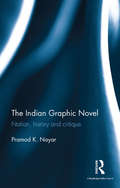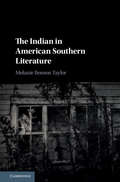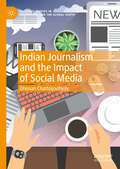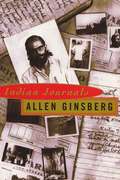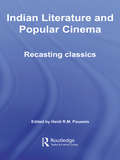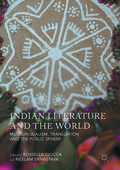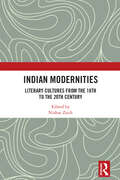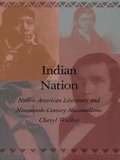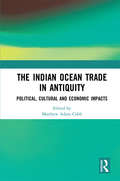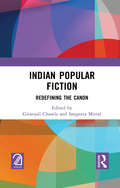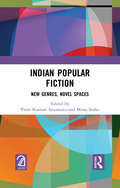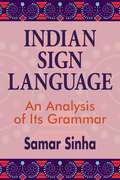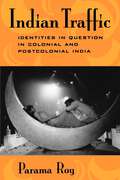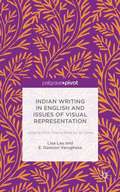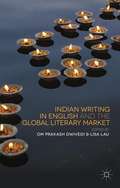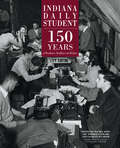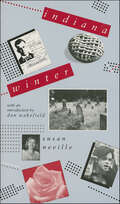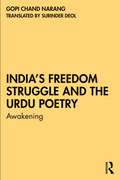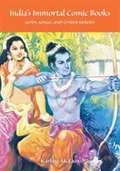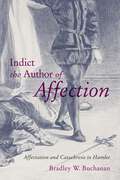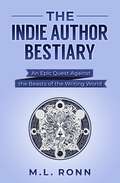- Table View
- List View
The Indian Graphic Novel: Nation, history and critique
by Pramod K. NayarThis book is a detailed study of the Indian graphic novel as a significant category of South Asian literature. It focuses on the genre’s engagement with history, memory and cultural identity and its critique of the nation in the form of dissident histories and satire. Deploying a nuanced theoretical framework, the volume closely examines major texts such as The Harappa Files, Delhi Calm, Kari, Bhimayana, Gardener in the Wasteland, Pao Anthology, and authors and illustrators including Sarnath Banerjee, Vishwajyoti Ghosh, Durgabai Vyam, Amrutha Patil, Srividya Natarajan and others. It also explores — using key illustrations from the texts — critical themes like contested and alternate histories, urban realities, social exclusion, contemporary politics, and identity politics. A major intervention in Indian writing in English, this volume will be of great importance to scholars and researchers of South Asian literature, cultural studies, art and visual culture, and sociology.
The Indian in American Southern Literature
by Melanie Benson TaylorIndians are everywhere and nowhere in the US South. Cloaked by a rhetoric of disappearance after Indian Removal, actual southeastern tribal groups are largely invisible but immortalized in regional mythologies, genealogical lore, romanticized stereotypes, and unpronounceable place names. These imaginary 'Indians' compose an ideological fiction inextricable from that of the South itself. Often framed as hindrances to the Cotton Kingdom, Indians were in fact active participants in the plantation economy and chattel slavery before and after Removal. Dialectical tropes of Indigeneity linger in the white southern imagination in order to both conceal and expose the tangle of land, labor, and race as formative, disruptive categories of being and meaning. This book is not, finally, about the recovery of the region's lost Indians, but a reckoning with their inaccessible traces, ambivalent functions, and the shattering implications of their repressed significance for modern southern identity.
Indian Journalism and the Impact of Social Media (Palgrave Studies in Journalism and the Global South)
by Dhiman ChattopadhyayThis book is a pan-India study that examines social media’s impact on Indian journalism, highlights emerging challenges, and discusses the way forward for India’s newsrooms. A result of three years of field work, the project uses mixed-methods research – a survey of nearly 300 journalists from 15 Indian cities, followed by in-depth interviews with 25 senior editors – to analyze and explain journalists’ perceptions about social media’s usefulness and credibility, factors that influence their online news sourcing and sharing decisions, resultant challenges for newsrooms, and ways to address those challenges. The findings offer unique insights into how newer forces are influencing journalistic practices in an online-first era. Key differences emerge in perceptions between Indian journalists and their Western compatriots about who or what influence their actions. The findings also raise questions about Gatekeeping as a term to describe journalistic work in 21st Century India's newsrooms. The findings and the conclusions will hopefully help journalists, educators, and anyone interested in Indian journalism gain a deeper, more meaningful understanding about social media’s impact on Indian journalism, and the way ahead for India’s newsrooms.
Indian Journals, March 1962 - May 1963: Notebooks, Diary, Blank Pages, Writings
by Allen Ginsberg"The leading poet of the Beat generation and late-twentieth century American letters, a spokesman for the antiwar generation, an icon of the counterculture, Allen Ginsberg led a movement that profoundly altered the American literary and cultural landscapes. Indian Journals collects Ginsberg's writing from a 1962-63 stay in India. It is wonderfully eclectic, visionary, at times intensely private, and always in possession of a hallucinatory clarity that affirms Ginsberg's truly great ability, as well as his ebullient spirit." "Indian Journals took half a decade to transcribe and edit; when it was originally published in 1970 it catalyzed a large movement of young Western pilgrims to explore India and Eastern thought. This new edition contains an updated and expanded section of newly discovered photographs taken by Ginsberg during his time spent in India. The perfect combination of text and images, Indian Journals is testimony to Ginsberg's passionate interest in Eastern religion and mysticism and contains the raw materials for some of his most important poems."--BOOK JACKET.Title Summary field provided by Blackwell North America, Inc. All Rights Reserved
Indian Literature and Popular Cinema: Recasting Classics (Routledge Contemporary South Asia Series)
by Heidi R.M.PauwelsThis book is about the popular cinema of North India ("Bollywood") and how it recasts literary classics. It addresses questions about the interface of film and literature, such as how Bollywood movies rework literary themes, offer different (broader or narrower) interpretations, shift plots, stories, and characters to accommodate the medium and the economics of the genre, sometimes even changing the way literature is read. This book addresses the socio-political implications of popular reinterpretations of "elite culture", exploring gender issues and the perceived "sexism" of the North Indian popular film and how that plays out when literature is reworked into film. Written by an international group of experts on Indian literature and film, the chapters in this book focus on these central questions, but also cover a wide range of literary works that have been adapted in film. Each part of the book discusses how a particular genre of literature has been "recast" into film. The individual chapters focus on comparisons and close studies of individual films or film songs inspired by "classics" of literature. The book will be of interest to those studying Indian film and literature and South Asian popular culture more generally.
Indian Literature and the World
by Rossella Ciocca Neelam SrivastavaThis book is about the most vibrant yet under-studied aspects of Indian writing today. It examines multilingualism, current debates on postcolonial versus world literature, the impact of translation on an "Indian" literary canon, and Indian authors' engagement with the public sphere. The essays cover political activism and the North-East Tribal novel; the role of work in the contemporary Indian fictional imaginary; history as felt and reconceived by the acclaimed Hindi author Krishna Sobti; Bombay fictions; the Dalit autobiography in translation and its problematic international success; development, ecocriticism and activist literature; casteism and access to literacy in the South; and gender and diaspora as dominant themes in writing from and about the subcontinent. Troubling Eurocentric genre distinctions and the split between citizen and subject, the collection approaches Indian literature from the perspective of its constant interactions between private and public narratives, thereby proposing a method of reading Indian texts that goes beyond their habitual postcolonial identifications as "national allegories".
Indian Modernities: Literary Cultures from the 18th to the 20th Century
by Nishat ZaidiThis volume studies the ways in which modernity has been conceived, practiced, and performed in Indian literatures from the 18th to 20th century. It brings together essays on writings in Hindi, Urdu, Punjabi, Bengali, Odia, Gujarati, Marathi, Tamil, Telugu, Kannada, Malayalam, and languages from Northeast India, which form a dialogical relationship with each other in this volume. The concurrence and contradictions emerging through these studies problematize the idea of modernity afresh. The book challenges the dominance of colonial modernity through socio-historical and cultural analysis of how modernity surfaces as a multifaceted phenomenon when contextualized in the multilingual ethos of India. It further tracks the complex ways in which modernism in India is tied to the harvests of modernity. It argues for the need to shift focus on the specific conditions that gave shape to multiple modernities within literatures produced from India. A versatile collection, the book incorporates engagements with not just long prose fiction but also lesser-known essays, research works, and short stories published in popular magazines. This unique work will be of interest to students and teachers of Indian writing in English, Indian literatures, and comparative literatures. It will be indispensable to scholars of South Asian studies, literary historians, linguists, and scholars of cultural studies across the globe.
Indian Nation: Native American Literature and Nineteenth-Century Nationalisms
by Cheryl WalkerIndian Nation documents the contributions of Native Americans to the notion of American nationhood and to concepts of American identity at a crucial, defining time in U.S. history. Departing from previous scholarship, Cheryl Walker turns the "usual" questions on their heads, asking not how whites experienced indigenous peoples, but how Native Americans envisioned the United States as a nation. This project unfolds a narrative of participatory resistance in which Indians themselves sought to transform the discourse of nationhood.Walker examines the rhetoric and writings of nineteenth-century Native Americans, including William Apess, Black Hawk, George Copway, John Rollin Ridge, and Sarah Winnemucca. Demonstrating with unique detail how these authors worked to transform venerable myths and icons of American identity, Indian Nation chronicles Native American participation in the forming of an American nationalism in both published texts and speeches that were delivered throughout the United States. Pottawattomie Chief Simon Pokagon's "The Red Man's Rebuke," an important document of Indian oratory, is published here in its entirety for the first time since 1893. By looking at this writing through the lens of the best theoretical work on nationality, postcoloniality, and the subaltern, Walker creates a new and encompassing picture of the relationship between Native Americans and whites. She shows that, contrary to previous studies, America in the nineteenth century was intercultural in significant ways.
The Indian Ocean Trade in Antiquity: Political, Cultural and Economic Impacts
by Matthew Adam CobbThe period from the death of Alexander the Great to the rise of the Islam (c. late fourth century BCE to seventh century CE) saw a significant growth in economic, diplomatic and cultural exchange between various civilisations in Africa, Europe and Asia. This was in large part thanks to the Indian Ocean trade. Peoples living in the Roman Empire, Parthia, India and South East Asia increasingly had access to exotic foreign products, while the lands from which they derived, and the peoples inhabiting these lands, also captured the imagination, finding expression in a number of literary and poetic works. The Indian Ocean Trade in Antiquity provides a range of chapters that explore the economic, political and cultural impact of this trade on these diverse societies, written by international experts working in the fields of Classics, Archaeology, South Asian studies, Near Eastern studies and Art History. The three major themes of the book are the development of this trade, how consumption and exchange impacted on societal developments, and how the Indian Ocean trade influenced the literary creations of Graeco-Roman and Indian authors. This volume will be of interest not only to academics and students of antiquity, but also to scholars working on later periods of Indian Ocean history who will find this work a valuable resource.
The Indian Periodical Press and the Production of Nationalist Rhetoric
by Sukeshi KamraConsiders the Indian periodical press as a key forum for the production of nationalist rhetoric. It argues that between the 1870s and 1910, the press was the place in which the notion of 'the public' circulated and where an expansive middle class, and even larger reading audience, was persuaded into believing it had force.
Indian Popular Fiction: Redefining the Canon
by Gitanjali Chawla Sangeeta MittalThis anthology explores and validate the nuances of Indian popular fiction which has hitherto been hounded by its ubiquitous 'commerical' success. It uncoverspopular in its socio-political and cultural contexts. Furthermore, it investigates the vitality embedded in theory and praxis of popular forms and their insurrections in mutants and new age oeuvres and looks to examine the symbiotic bonds between the reader and the author, as the latter articulates and perpetuates the needs of the former whose demands need continual fulfilment. This constant metamorphosis of the popular fueled by neoliberalism and postmodernity along with the shifts in the publishing industry to more democratic 'reader' driven genres is taken up here along with the millenial's fetish for romance, humanized mythical retellings and the evergreen whodunnits. As its natural soulmates, the anthology delves into the interstices of Indian Popular with desi (local) traditions, folk lore, community consciousness and nation building.Please note: This title is co-published with Manohar Publishers, New Delhi. Taylor & Francis does not sell or distribute the Hardback in India, Pakistan, Nepal, Bhutan, Bangladesh and Sri Lanka.
Indian Popular Fiction: New Genres, Novel Spaces
by Prem Kumari Srivastava, Mona Sinha and Tabish KhairThe scholarly essays in this book open up experimental and novel spaces and genres beyond the traditional and the literary world of Indian Popular Fiction as it existed towards the end of the last millennium. They respond to the possibilities opened up by the technology-driven and internet-savvy reading and writing world of today. Contemporaneous and bold, most of the essays resonate with the racy and fast-paced milieu and social media space inhabited by today's youth. Combative in its drift, this book makes possible an attempt to disband hierarchies and dismantle categories that have engulfed the expansive landscape of Indian Popular Fiction for too long. It facilitates discussion on graphic novels, microfiction, popular-entertainment and political satire on television and celluloid, social media-driven romances existing in the domain of the 'real' rather than that of 'fantasy' and mythological readings against the backdrop of gender and politics. Aimed at facilitating further research by scholars and enthusiasts of Indian Popular Fiction, this book is also an ode to the current trends generated by social and internet media cosmos. This book is co-published with Aakar Books, New Delhi. Taylor & Francis does not sell or distribute the print versions of this book in India, Pakistan, Nepal, Bhutan, Bangladesh and Sri Lanka.
Indian Sign Language: An Analysis of Its Grammar
by Samar SinhaSamar Sinha presents pioneering research into the grammatical properties of Indian Sign Language (ISL), a language used by members of the Deaf community in India. This detailed and well-illustrated study describes the grammar of ISL and is supplemented by comparative and theoretical analyses in the core areas of sublexical structure, morphology, and syntax. Sinha offers a field-based, comprehensive analysis that covers topics such as o sign formation parameters o syllable structure o sonority hierarchy o semantics of space o pluralization strategies o phi-features o indexing and localization o agreement o word order He provides a description of the Indian Deaf community that serves to frame his analysis of ISL and highlights the need for greater awareness and acknowledgment of the language and its users. The lack of research on ISL in Indian academia has slowed efforts toward the standardization of ISL and the development of pedagogical materials. This work adds to the growing understanding of natural human language in general and ISL in particular. It also contributes to the empowerment of the Deaf community in India and will strengthen the efforts carried out by d/Deaf activists and researchers.
Indian Traffic: Identities in Question in Colonial and Postcolonial India
by Parama RoyThe continual, unpredictable, and often violent "traffic" between identities in colonial and postcolonial India is the focus of Parama Roy's stimulating and original book. Mimicry has been commonly recognized as an important colonial model of bourgeois/elite subject formation, and Roy examines its place in the exchanges between South Asian and British, Hindu and Muslim, female and male, and subaltern and elite actors. Roy draws on a variety of sources—religious texts, novels, travelogues, colonial archival documents, and films—making her book genuinely interdisciplinary. She explores the ways in which questions of originality and impersonation function, not just for "western" or "westernized" subjects, but across a range of identities. For example, Roy considers the Englishman's fascination with "going native," an Irishwoman's assumption of Hindu feminine celibacy, Gandhi's impersonation of femininity, and a Muslim actress's emulation of a Hindu/Indian mother goddess. Familiar works by Richard Burton and Kipling are given fresh treatment, as are topics such as the "muscular Hinduism" of Swami Vivekananda.Indian Traffic demonstrates that questions of originality and impersonation are in the forefront of both the colonial and the nationalist discourses of South Asia and are central to the conceptual identity of South Asian postcolonial theory itself.
Indian Writing In English
by K.R. Srinivasa IyengarThis book talks about Indian authours who contributed to English Literature like Sarojini Naidu,Sri Aurobindo,Rabindranath Tagore etc and their significant works.
Indian Writing in English and Issues of Visual Representation: Judging More Th an a Book by Its Cover
by Lisa Lau E. Dawson VarugheseThis book examines the use of book covers as marketing devices, asking what exactly they communicate to their readers and buyers, and what images they associate with a genre and create about a culture. Focusing on Indian women's writing in English, it combines the study of text with the study of materiality of the book.
Indian Writing in English and the Global Literary Market
by Om Prakash DwivediIndian Writing in English and the Global Literary Market delves into the influences and pressures of the marketplace on this genre, contending that it has been both a gatekeeper and a significant force in shaping the production and consumption of this literature. As well as providing case studies of selected contemporary Indian novels in English and comparing how diasporic authors fare compared to authors within India, this volume also provides theoretical insights into the postcolonial framework in which the global literary marketplace is embedded, and comments on the exoticization and marketing strategies adopted as a result.
Indiana Daily Student: 150 Years of Headlines, Deadlines and Bylines (Well House Books)
by Rachel Kipp, Amy Wimmer Schwarb and Charles ScudderThe story of a student-produced newspaper since its debut in 1867—including photos, coverage of historic events, and reminiscences from prominent alumni.Generations of student journalists, armed with notepads, cameras, and a tireless devotion, have pursued both local and national stories for the student-produced newspaper at Indiana University Bloomington since its debut in 1867.In Indiana Daily Student: 150 Years of Headlines, Deadlines and Bylines, editors and IDS alumni Rachel Kipp, Amy Wimmer Schwarb, and Charles Scudder piece together behind-the-scenes remembrances from former IDS reporters and photographers, newsroom images from throughout the decades, and a curated collection of notable IDS front pages. From coverage of the end of World War I to the selection of Herman B. Wells as IU’s president to the Hoosiers’ national basketball championship titles to the terrorist attacks of Sept. 11, 2001, the IDS has chronicled news from a student perspective. Today, it serves as a training ground for fledgling journalists who have gone on to be monumental voices in American and global media.Remembrances from some of the most prominent journalists to emerge from the IDS are included here: among them, publisher and journalism philanthropist Nelson Poynter; National Public Radio television critic Eric Deggans; and Pulitzer Prize winners Ernie Pyle, Thomas French, and Melissa Farlow. While at IU, students at the IDS built and maintained beloved traditions they continue to share today, all while offering a full spectrum of coverage for their readers. The first book on the paper’s history, Indiana Daily Student offers a comprehensive celebration of the newspaper’s achievements, as well as historic front pages, photographs, and personal narratives from current and former IDS journalists.
Indiana Holt Elements of Literature: Sixth Course, Essentials of British and World Literature
by Holt Rinehart WinstonNIMAC-sourced textbook
Indiana Winter
by Susan Neville"Neville's observations on inner and outer worlds deserve a large readership." —Studies in Short Fiction"Blending fictional and reportorial technique, Ms. Neville unwinds a tapestry of the Indiana seasons . . . in scene after remarkable scene she succeeds in disturbing and undermining one's calm. . . . moving . . . " —Christopher Lehmann-Haupt, The New York Times" . . . shrewedly perceptive studies of the poetics of place . . . Neville pierces the heart of this 'heart of the country,' unloosing disquieting images and poignant scenes that cling to your memory." —Belles Lettres"If there is darkness in this vision there is also compassion, a lucid and inclusive civility born of remembering how fragile are the houses of our lives." —Arts Indiana"A collection of essays, works of fiction and blends of those two genres, Indiana Winter is a poetic and disturbing interpretation of phenomena familiar to most of Neville's fellow Hoosiers—so familiar, in fact, that we may not really see them. . . . As a plunge into the blackness and glare of the examined life, Indiana Winter is a testament to courage." —Dan Carpenter, Indianapolis Star"These stories and essays are filled with great emotion and affection for the people and the land we've come to know as the Hoosier state." —Minneapolis Star Tribune" . . . a book that is firmly and honestly rooted in region, yet finds in its careful and lyrical examination of Indiana's people and places truths that move the prose pieces away from simple regionalism." —Sycamore ReviewA sensitive writer's imaginative essay-stories about spiritual boundaries and values in the state of Indiana and everywhere.
India’s Freedom Struggle and the Urdu Poetry: Awakening
by Gopi Chand NarangPoetry, mainly Urdu poetry, played a very significant role in India’s freedom struggle. This book explores the poetic contributions going back centuries of colonial rule, which became songs of freedom and captured both the poignancy and fervor of revolution, protest, and hope. Urdu became one of the essential languages in colonial India, used by both political leaders and many young revolutionaries in speeches and writings as slogans for freedom and a call to action. Poets such as Josh Malihabadi, Firaq Gorakhpuri, Sahir, Makhdoom, Kaifi Azmi, Majaz, Majrooh, and Faiz Ahmad Faiz wrote highly patriotic poetry which was used not only to inspire and help mobilize people but also to offer criticism of existing socio-cultural practices in India and promote reform and equality. This work – a creative and selective translation of the book Hindustan Ki Tahriik-e Aazadi aur Urdu Shaa’yiri by Professor Gopi Chand Narang – includes English translations of poems from rare historical manuscripts as well as banned and witnessed poetry confiscated by the British. It looks at key events in India’s struggle for freedom through the prism of literature, language, poetry, and culture while also delving into the lives of poets who became the voice of their generation. This book is an essential read for students and researchers of colonial and postcolonial literature, cultural studies, comparative studies, history, and South Asian literature and culture.
India's Immortal Comic Books: Gods, Kings, And Other Heroes
by Karline McLainCombining entertainment and education, India's most beloved comic book series, Amar Chitra Katha, or "Immortal Picture Stories," is also an important cultural institution that has helped define, for several generations of readers, what it means to be Hindu and Indian. Karline McLain worked in the ACK production offices and had many conversations with Anant Pai, founder and publisher, and with artists, writers, and readers about why the comics are so popular and what messages they convey. In this intriguing study, she explores the making of the comic books and the kinds of editorial and ideological choices that go into their production.
Indict the Author of Affection: Affectation and Catachresis in Hamlet
by Bradley W. BuchananMany scholars have touched tangentially on the topic of affectation in Hamlet, but none have yet offered an adequate rhetorical analysis of Shakespeare’s treatment of the concept. Making the claim that affectation is an anomalous affective malady that afflicts nearly everyone in the play, Bradley Buchanan explores the many manifestations of affectation at the court of Elsinore in light of classical rhetorical theory, as well as in the broader context of early modern intellectual culture. Buchanan shows that the special twist in Shakespeare’s depictions of affectation lies in the catachrestic abuse of the older English word “affection” by Hamlet himself (among other characters) to signify the new, foreign concept of affectation. This disturbing conflation of two opposing conditions encapsulates Hamlet’s much-discussed problem: he cannot tell the difference between genuine affection and deceptive affectation. Drawing on a growing field of scholarship engaged in the study of rhetoric in early modern English texts, Indict the Author of Affection explores how Shakespeare’s extensive and self-conscious use of catachresis involves not only far-fetched metaphors but subversive new meanings that can infect familiar words, dramatizing his characters’ psychological conflicts and producing a rich but treacherous instability in language itself.Indict the Author of Affection brings to Hamlet a groundbreaking analysis engaged with the complex, wide-ranging, and contentious discourse concerning affectation as a rhetorical, moral, and aesthetic issue.
The Indie Author Atlas: Your Guide to the Five Continents of the Writing World (Author Level Up #8)
by M.L. RonnYOUR PASSPORT TO THE FIVE CONTINENTS OF THE WRITING WORLD Have you ever felt overwhelmed by the sheer amount of information you have to learn as a writer? The Indie Author Atlas eliminates overwhelm and makes the art of learning to be a writer fun. It turns the major concepts writers need to learn into can’t-miss vacation destinations. Ready to get away? Pamper yourself at the pristine beachfronts at the Strategy Islands Get lost in the expansive continent of Craft Discover new marketing strategies in the desert continent of Marketstan Tap into your inner entrepreneur in the sacred Lands of Distribution And more! This quirky and engaging guide is written in the style of a travel guide, and it also has illustrated maps for each continent. The Indie Author Atlas is unlike any other book for writers you’ve ever read. Relax and have fun as you wander through the amazing continents of the writing life. You just might learn something. Click the buy button and book your dream writing vacation today! V1.0
The Indie Author Bestiary: An Epic Quest Against the Beasts of the Writing World (Author Level Up #7)
by M.L. RonnYOUR GUIDE TO SLAYING THE BEASTS OF THE WRITING WORLD Do the “beasts” of the writing life trouble you? Fear, self-doubt, overwhelm, the inferiority complex, and more? If so, you’re not alone. These “beasts” of the writing world want to destroy writers everywhere, but they can only hurt us if we let them. This guide will teach you to do battle with the beasts that are sure to show up in your writing career. It will teach you to slay them once and for all. Fight fear with every ounce of your being Beat burnout at its own game Overcome feelings of inadequacy and self-doubt And more! If you struggle with the “emotional” part of being a writer, The Indie Author Bestiary will be your sword. This unique book takes the emotional challenges of writing, converts them into monsters, and teaches you how to defeat them. Are you ready to conquer the beasts of the writing world? V1.0
